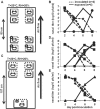Transmission of influenza virus via aerosols and fomites in the guinea pig model
- PMID: 19434931
- PMCID: PMC4180291
- DOI: 10.1086/597073
Transmission of influenza virus via aerosols and fomites in the guinea pig model
Abstract
Limited data on the relative contributions of different routes of transmission for influenza virus are available. Person-to-person transmission is central to seasonal and pandemic spread; nevertheless, the modes of spread are a matter of ongoing debate. Resolution of this discussion is paramount to the development of effective control measures in health care and community settings. Using the guinea pig model, we demonstrated that transmission of influenza A/Panama/2007/1999 (H3N2) virus through the air is efficient, compared with spread through contaminated environmental surfaces (fomites). We also examined the aerosol transmission efficiencies of 2 human influenza virus A strains and found that A/Panama/2007/1999 influenza virus transmitted more efficiently than A/Texas/36/1991 (H1N1) virus in our model. The data provide new and much-needed insights into the modes of influenza virus spread and strain-specific differences in the efficiency of transmission.
Figures




References
-
- Thompson WW, Shay DK, Weintraub E, et al. Influenza-associated hospitalizations in the United States. JAMA. 2004;292:1333–40. - PubMed
-
- Thompson WW, Shay DK, Weintraub E, et al. Mortality associated with influenza and respiratory syncytial virus in the United States. JAMA. 2003;289:179–86. - PubMed
-
- Committee on Personal Protective Equipment for Healthcare Workers during an Influenza Pandemic. Institute of Medicine . Preparing for an influenza pandemic: personal protective equipment for healthcare workers. In: Goldfrank LR, Liverman CT, editors. Washington, DC: National Academies Press; 2008.
-
- Bridges CB, Kuehnert MJ, Hall CB. Transmission of influenza: implications for control in health care settings. Clin Infect Dis. 2003;37:1094–101. - PubMed
-
- Centers for Disease Control and Prevention Infection control guidance for the prevention and control of influenza in acute-care facilities. Available at: http://www.cdc.gov/flu/professionals/infectioncontrol/healthcarefaciliti.... Accessed 21 January 2009.
Publication types
MeSH terms
Substances
Grants and funding
LinkOut - more resources
Full Text Sources
Medical

